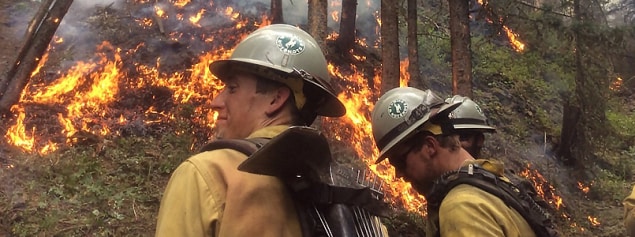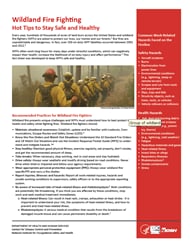Fighting Wildfires

Members of the Wyoming Wildland Firefighter Hotshot Crew monitor burn as it makes its way down a hillside. Image is courtesy of the US Forest Service Technology and Development Program.
Every year, millions of acres of land burn across the United States and wildland firefighters (WFFs) are asked to protect our lives, our homes, and our forests. But fires are unpredictable and dangerous. Over 400 on-duty WFF fatalities occurred between 2000-2019, based on data compiled in the NIOSH Wildland Firefighter On-Duty Death Surveillance System from three data sources. 1,2,3 Common hazards faced on the fire line can include burnovers/entrapments, heat-related illnesses and injuries, smoke inhalation, vehicle-related injuries (including aircraft), slips, trips, and falls, and others.4 In addition, due to prolonged intense physical exertion, WFFs are at risk for sudden cardiac deaths and rhabdomyolsis.
NIOSH offers resources for fire departments, firefighters, and partner organizations to prevent on-duty injuries, illnesses, and deaths from hazards and exposures associated with fighting wildfires.
CDC and NIOSH also provide resources for workers and homeowners regarding hazards they encounter when cleaning up after a wildfire.
- Federal Emergency Management Agency, Fire Administration (US). [2017] Fire Fighter Fatalities in the United States. Date accessed: January, 2017.
- National Wildfire Coordinating Group, Risk Management Committee. [2017] Safety Gram Archive. Date Accessed January, 2017.
- National Fire Protection Association (US). [2017] Fatalities and Injuries. Date accessed: January, 2017.
- Britton C, et al., Epidemiology of injuries to wildland firefighters. Am J Emerg Med. 2013 Feb; 31(2):339-45. [Epub 2012 Nov 15].

